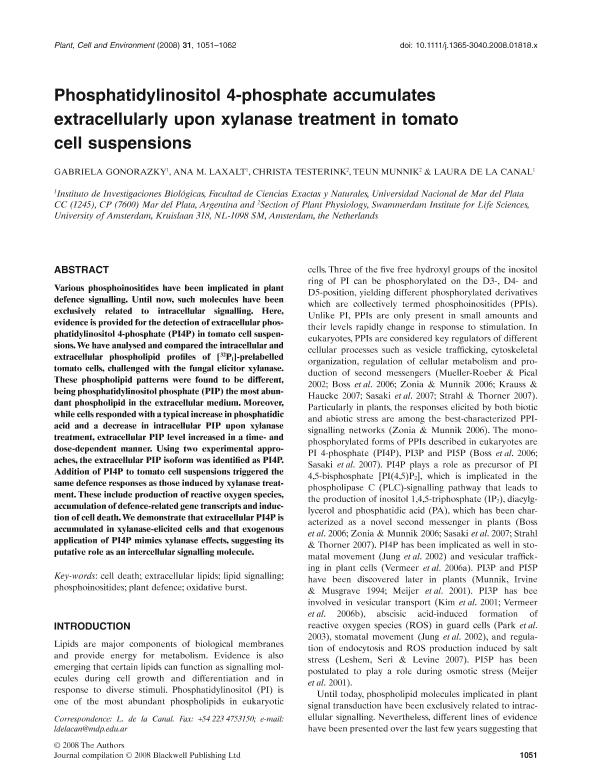Artículo
Phosphatidylinositol 4-phosphate accumulates extracellularly upon xylanase treatment in tomato cell suspensions
Fecha de publicación:
08/2008
Editorial:
Wiley Blackwell Publishing, Inc
Revista:
Plant, Cell and Environment
ISSN:
0140-7791
Idioma:
Inglés
Tipo de recurso:
Artículo publicado
Clasificación temática:
Resumen
Various phosphoinositides have been implicated in plant defence signalling. Until now, such molecules have been exclusively related to intracellular signalling. Here, evidence is provided for the detection of extracellular phosphatidylinositol 4-phosphate (PI4P) in tomato cell suspensions. We have analysed and compared the intracellular and extracellular phospholipid profiles of [(32)P(i)]-prelabelled tomato cells, challenged with the fungal elicitor xylanase. These phospholipid patterns were found to be different, being phosphatidylinositol phosphate (PIP) the most abundant phospholipid in the extracellular medium. Moreover, while cells responded with a typical increase in phosphatidic acid and a decrease in intracellular PIP upon xylanase treatment, extracellular PIP level increased in a time- and dose-dependent manner. Using two experimental approaches, the extracellular PIP isoform was identified as PI4P. Addition of PI4P to tomato cell suspensions triggered the same defence responses as those induced by xylanase treatment. These include production of reactive oxygen species, accumulation of defence-related gene transcripts and induction of cell death. We demonstrate that extracellular PI4P is accumulated in xylanase-elicited cells and that exogenous application of PI4P mimics xylanase effects, suggesting its putative role as an intercellular signalling molecule.
Archivos asociados
Licencia
Identificadores
Colecciones
Articulos(IIB)
Articulos de INSTITUTO DE INVESTIGACIONES BIOLOGICAS
Articulos de INSTITUTO DE INVESTIGACIONES BIOLOGICAS
Citación
Gonorazky, Ana Gabriela; Laxalt, Ana Maria; Testerink, Christa; Munnik, Teun; de la Canal, Laura; Phosphatidylinositol 4-phosphate accumulates extracellularly upon xylanase treatment in tomato cell suspensions; Wiley Blackwell Publishing, Inc; Plant, Cell and Environment; 31; 8; 8-2008; 1051-1062
Compartir
Altmétricas




